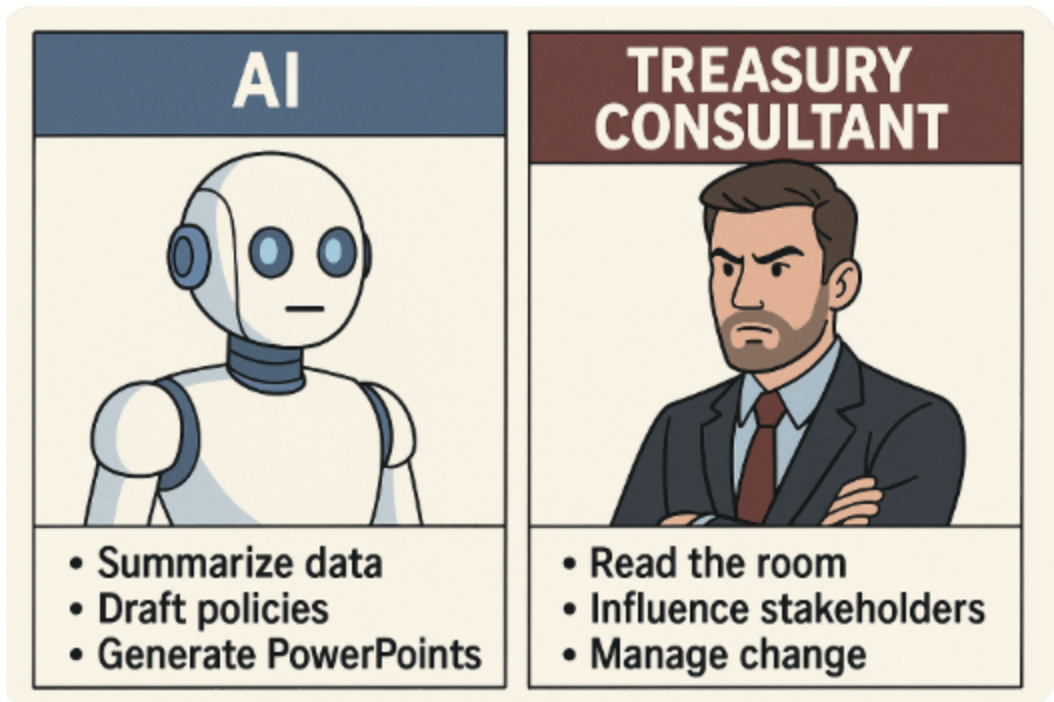Every now and then, when discussing interim treasury support, the conversation takes a strange turn: the client pulls out the salary range of the permanent role and suggests using it as a benchmark for the interim’s fee.
Let’s be clear: that’s comparing apples to oranges.
Interims Are Not Permanent Employees
A permanent hire is a long-term investment. Salary is part of a package that includes benefits, pension, bonus schemes, training, and…let’s be honest – a long onboarding curve. You hire potential, then build it up over the years.
An interim treasurer, on the other hand, is:
- Immediate capacity: They can start within days, not months.
- Plug-and-play expertise: They’ve seen dozens of treasury setups, projects, and crises. They don’t need a ramp-up period.
- Flexible by design: If the project ends early or priorities shift, you can end the assignment with minimal strings attached.
This flexibility and impact come at a premium.
Risk vs. Reward
Interims are freelancers. That means no job security, no paid holidays, no pension, no guarantees. They take on short-term risk so you don’t have to. Their higher daily or monthly rate reflects that.
In practice, you’re not paying for “X months of work.” You’re paying for:
- Speed – getting someone in place tomorrow.
- Quality – a treasurer who already knows the systems, banks, and processes.
- Outcomes – stabilization, improvements, or project delivery without delay.
The Hidden Cost of Delay
Let’s flip the question: what’s the cost of not having someone in place?
- Unhedged FX exposures.
- Missed investment opportunities.
- Compliance risks.
- Overstretched teams are making mistakes.
Compared to those risks, an interim’s fee is often the cheapest insurance policy you’ll ever buy.
ROI: More Than Just a Cost
There’s another angle often overlooked: the return on investment (ROI). In roughly half of my projects, the savings or gains I generated for clients were greater than my total cost. Examples include:
- Cash centralisation that freed up idle liquidity.
- Bank fee reviews that cut six-figure costs.
- Sharper FX execution that reduced margins and slippage.
One client paid around €80k for an interim assignment, and within six months, we saved them €200k in unnecessary bank fees. That’s a 2.5x return on investment.
So while the interim rate looks higher than a permanent salary, the net effect for the client can be cost-neutral, or even cash-positive.
Interims vs. Big 4 Consultants
If you compare an interim treasurer’s rate to a permanent salary, it may look steep. But compare it to a Big 4 consultant’s hourly rate, and suddenly it doesn’t.
With the Big 4, you’re not only paying for expertise, you’re also paying heavily for the brand name, overhead, and layers of management. The person on the ground might be smart, but often less experienced than an interim who has already run multiple treasury departments hands-on.
When you line them up side by side, the interim often looks like the more cost-effective and pragmatic choice. It’s all in the comparison.
Final Word
Permanent hires and interims both play crucial roles – but they are not substitutes for each other, and they should never be priced the same way.
When you need time, stability, and potential, you hire a permanent treasurer.
When you need expertise, speed, and results, you bring in an interim.
Simple as that.
Transparent Pricing at Pecunia
At Pecunia, we keep things simple. We are fully transparent about our pricing and our margin, unlike many recruiters who keep those numbers hidden. On average, our margin is just 10%, and we openly publish our pricing on the Find Your Interim page.
No surprises. No hidden markups. Just experienced treasurers matched quickly and fairly.
| Factor | Permanent Hire | Interim Treasurer | Big 4 Consultant |
| Cost Basis | Annual salary + bonus + pension + benefits | Daily/Monthly fee (all-in, flexible) | Hourly/daily fee (plus overhead & brand premium) |
| Speed to Start | 3–6 months (recruitment + notice) | Days to weeks | Weeks to months (depending on project scope) |
| Expertise | Potential + company-specific learning | Plug-and-play, 10–20+ years treasury | Varies – often juniors with partner oversight |
| Flexibility | Long-term contract, harder to exit | End assignment anytime | Bound to project scope, contract-heavy |
| Hidden Costs | Training, onboarding, benefits, severance | None – all-in cost | Travel, overhead, multiple billing layers |
| ROI Potential | Long-term value creation | Frequently generates savings > cost (cash pooling, bank fees, FX) | Process-heavy, ROI harder to prove |
| What You Pay For | Capacity + loyalty | Expertise + speed + flexibility | Brand name + slide decks + audit trail |













